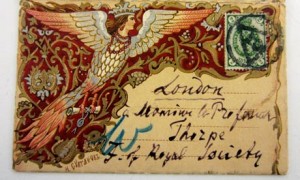It’s been quite the year. In Feb. 2014, TED offered me free livestreaming of the event in Vancouver. In March/April 2014, Google tweaked its search function and sometime in September 2014 I decided to publish two pieces per day rather than three with the consequence that the visit numbers for this blog are lower than they might otherwise have been. More about statistics and traffic to this blog will be in the post I usually publish just the new year has started.
On other fronts, I taught two courses (Bioelectronics and Nanotechnology, the next big idea) this year for Simon Fraser University (Vancouver, Canada) in its Continuing Studies (aka Lifelong Learning) programmes. I also attended a World Congress on Alternatives to Animal Testing in the Life Sciences in Prague. The trip, sponsored by SEURAT-1 (Safety Evaluation Ultimately Replacing Animal Testing), will result in a total of five stories, the first having been recently (Dec. 26, 2014) published. I’m currently preparing a submission for the International Symposium on Electronic Arts being held in Vancouver in August 2015 based on a project I have embarked upon, ‘Steep’. Focused on gold nanoparticles, the project is Raewyn Turner‘s (an artist from New Zealand) brainchild. She has kindly opened up the project in such a way that I too can contribute. There are two other members of the Steep project, Brian Harris, an electrical designer, who works closely with Raewyn on a number of arts projects and there’s Mark Wiesner as our science consultant. Wiesner is a professor of civil and environmental engineering,at Duke University in North Carolina.
There is one other thing which you may have noticed, I placed a ‘Donate’ button on the blog early in 2014.
Acknowledgements, good-byes, and hellos
Dexter Johnson on his Nanoclast blog (on the IEEE [Institute of Electrical and Electronics Engineers] website) remains a constant in the nano sector of the blogosphere where he provides his incisive opinions and context for the nano scene.
David Bruggeman on his Pasco Phronesis blog offers valuable insight into the US science policy scene along with a lively calendar of art/science events and an accounting of the science and technology guests on late night US television.
Andrew Maynard archived his 2020 Science blog in July 2014 but he does continue writing and communication science as director of the University of Michigan Risk Science Center. Notably, Andrew continues to write, along with other contributors, on the Risk Without Borders blog at the University of Michigan.
Sadly, Cientifica, a emerging technologies business consultancy, where Tim Harper published a number of valuable white papers, reports, and blog postings is no longer with us. Happily, Tim continues with an eponymous website where he blogs and communicates about various business interests, “I’m currently involved in graphene, nanotechnology, construction, heating, and biosensing, working for a UK public company, as well as organisations ranging from MIT [Massachusetts Institute of Technology] to the World Economic Forum.” Glad to you’re back to blogging Tim. I missed your business savvy approach and occasional cheekiness!
I was delighted to learn of a new nano blog, NanoScéal, this year and relieved to see they’re hanging in. Their approach is curatorial where they present a week of selected nano stories. I don’t think a lot of people realize how much work a curatorial approach requires. Bravo!
Sir Martyn Poliakoff and the Periodic Table of Videos
Just as I was wondering what happened to the Periodic Table of Videos (my April 25, 2011 post offers a description of the project) Grrl Scientist on the Guardian science blog network offers information about one of the moving forces behind the project, Martyn Poliakoff in a Dec. 31, 2014 post,
This morning [Dec. 31, 2014], I was most pleased to learn that Martyn Poliakoff, professor of chemistry at the University of Nottingham, was awarded a bachelor knighthood by the Queen. So pleased was I that I struggled out of bed (badly wrecked back), my teeth gritted, so I could share this news with you.
…
Now Professor Poliakoff — who now is more properly known as Professor SIR Martyn Poliakoff — was awarded one of the highest civilian honours in the land, and his continued online presence has played a significant role in this.
…
“I think it may be the first time that YouTube has been mentioned when somebody has got a knighthood, and so I feel really quite proud about that. And I also really want to thank you YouTube viewers who have made this possible through your enthusiasm for chemistry.”
As for the Periodic Table of Videos, the series continues past the 118 elements currently identified to a include discussions on molecules.
Science Borealis, the Canadian science blog aggregator, which I helped to organize (albeit desultorily), celebrated its first full year of operation. Congratulations to all those who worked to make this project such a success that it welcomed its 100th blog earlier this year. From a Sept. 24, 2014 news item on Yahoo (Note: Links have been removed),
This week the Science Borealis team celebrated the addition of the 100th blog to its roster of Canadian science blog sites! As was recently noted in the Council of Canadian Academies report on Science Culture, science blogging in Canada is a rapidly growing means of science communication. Our digital milestone is one of many initiatives that are bringing to fruition the vision of a rich Canadian online science communication community.
The honour of being syndicated as the 100th blog goes to Spider Bytes, by Catherine Scott, an MSc [Master of Science] student at Simon Fraser University in Burnaby, British Columbia. …
As always, it’s been a pleasure and privilege writing and publishing this blog. Thank you all for your support whether it comes in the form of reading it, commenting, tweeting, subscribing, and/or deciding to publish your own blog. May you have a wonderful and rewarding 2015!

